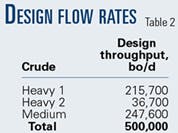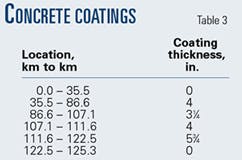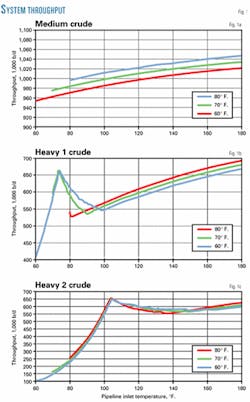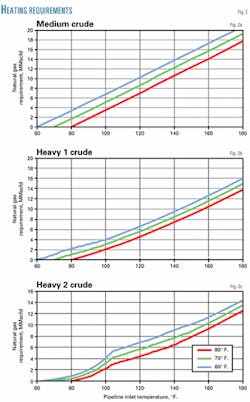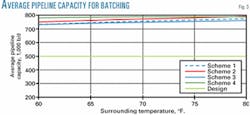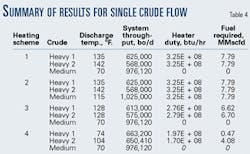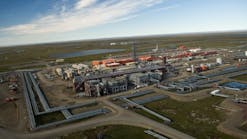New operation strategies in heavy crude pipeline will increase profit margin
An engineering study for a heavy-oil pipeline in Venezuela has confirmed the design of optimizing the temperature of crude entering the pipeline to levels that will increase throughput and reduce the size of the heaters at the pump station.
The study found that throughput for heavy crude pipelines is not necessarily a simple function of crude inlet temperature as commonly believed in normal crude pipelines.
Varying the pipeline inlet temperature for each type of crude enables the optimization of pipeline capacity and minimize heating costs.
Of four heating schemes evaluated, one yielded the lowest heater capital and fuel costs. This operational procedure required delicate control of crude temperature to balance heating and pumping performances. Heater installation and annual operating costs could be reduced by 25% to 60% in comparison with other evaluated operating procedures.
With significant reduction in equipment capitals cost and increased operating profit found in this study, the use of such new operation strategies is highly attractive. Potential profits by operating the pipeline in this new procedure should be explored by pipeline operators and designers.
A simple test program should be conducted to establish the flow-temperature relationship for various crude oils
Heavy-oil pipelines
Transporting heavy crude by pipeline consumes large amounts of mechanical energy, largely due to its viscosity, which is several hundred times that of a normal crude.
The movement of heavy crude creates a much greater frictional resistance in the pipeline to be compensated for by larger line pipe and more pumping horsepower than is normally required for a light crude.
This resistance depends strongly on crude oil viscosity, which increases significantly as its temperature drops along the pipeline. Cooling of the crude occurs as it flows through the pipeline, losing its thermal energy to the surroundings.
Insulating or heat tracing the pipeline is effective for reducing the cooling rate and often is crucial for maintaining adequate flows. Such a design, however, will increase capital outlays and increase the costs of pipeline installation.
Where insulation and heat-tracing methods are impractical, consideration must be given to simplifying the design and minimizing the size of the pipeline.
In the meantime, the unique thermal dynamics benefits of the heavy crude must be explored, as they were for this study of a Venezuelan heavy-oil pipeline.
This article will demonstrate how these benefits can be realized in heavy- crude pipeline projects.
A crude oil is usually classified as light if it has greater than 30º API gravity; a medium crude oil has a gravity of 22-30º API; while the gravity of a heavy crude oil is less than 22º API.
Vast amounts of heavy crude are produced in many parts of the world. Venezuela Orinoco heavy oil belt bitumen upgrades, Canadian Athabasca tar sands, and Labrador are some of the major suppliers of heavy crude.
Demand for heavy crude projects fell when oil prices dropped in 1998 and 1999 until the Organization of Petroleum Exporting Countries drastically cut crude oil production.
Since that cut, oil prices rose to more than $30/bbl in the summer of 2002. With stable, firm oil prices and increased world demand, interest in heavy-crude pipelines will soon revive.
The last heavy-crude pipeline under construction in 1997 in Venezuela was a 200 km (124 mile), 36-in. line to transport heavy crude from the Zuata region of the Orinoco Petroleum Belt of Venezuela to an export terminal near Barcelona.
The crude oil transported in this pipeline has a gravity of 9º to 15º API and a viscosity from 20,000 to 1,000 cst at standard conditions.
This heavy crude is blended with naphtha to a gravity of about 16º API and a manageable viscosity of about 400 cst. Blending heavy crude such as bitumen with naphtha produces a homogeneous mixture of Newtonian fluid characteristics.
The design capacity of this pipeline exceeds 500,000 b/d. The addition of an intermediate pump station would increase this flow rate by more than 200,000 b/d. The blended oil is pumped and heated to a typical temperature of 180º F. before entering the pipeline.
Pipeline project
In tandem with this project, a pipeline was proposed to transport medium and heavy crude oils 125 km from an existing oil export terminal to a new oil export terminal in Venezuela.
The proposed pipeline was designed to transport three types of crude oil with physical properties shown in Table 1.
The crude oils enter the pipeline in batches at a cycle of 2-6 days. The batch size ranges from less than 100,000 to more than 700,000 bbl, depending on storage availability, interface contamination, throughput requirements, and batching schemes.
Depending on the size of the pipeline ultimately selected, as many as six batches can flow simultaneously in the pipeline. To simplify the operation, spheres were not required to isolate oil batches.
Design capacity of this pipeline was 500,000 b/d initially and could be expanded to more than 750,000 b/d with a mid-point booster station. Only heavy crude had to be heated at the beginning of the pipeline.
Table 2 shows throughput requirements for the various crude oils to be transported.
The proposed route was fairly flat, traversing relatively flat and shallow bodies of water, including rivers, bays, and gulf, for a total distance of 125 km.
The pipeline is designed to operate at a maximum allowable operating pressure (MAOP) of 1,461 psig. This pressure limit is based on OD/WT (or, D/t) ratio criterion for offshore pipeline installation. In this case a ratio of 64 was found to be adequate. Based on API-5L Grade X-65 pipe, the 36-in. pipeline will have a 0.562 in. WT.
Based on preliminary information on-bottom current conditions, Table 3 shows the concrete weight coating thicknesses.
Fluid dynamics
Flow regime for any petroleum liquid is a function of the Reynolds number, which strongly affects thermal and fluid dynamics of crude oils. Light and medium crude oil pipelines are frequently operated at fully turbulent regions, in which temperature and pressure differentials are governed by the traditional turbulent-flow theory.
The most commonly used formula for calculating pressure drops in turbulent flow is the Darcy Weisbach equation.
Heat transfer between pipe wall and crude oil for the turbulent flow regime is related to the Reynolds and Prandtl number. Heat transfer in this regime is much more efficient than heat conduction across pipe walls and the surrounding environment and, for practical reasons, is often taken as infinity.
As the result, the crude oil temperature can be conveniently assumed to be equal to that of the pipe wall. Temperature and pressure differentials can be readily calculated for a given pipe size, pipe WT, coatings, flow rate, and surroundings.
When the Reynolds number is small, such as less than 2,100, laminar flow theory generally applies for determining temperature and pressure drops. In this regime, heat transfer and friction coefficients are a simple function of the Nusselt and Reynolds number. A heavy crude oil pipeline is often operated in this region because of its high viscosity.
As will be shown presently, operating the pipeline at near the laminar flow regime could reduce internal heat-transfer coefficient and may prevent heat loss to occur from the pipeline that could, in some cases, increase throughput.
As the Reynolds number is further reduced with lower operating temperature, laminar frictional effect begins to play a more dominant role that ultimately diminishes throughput.
Heating scheme
The crude oils can be heated differently at the beginning of the pipeline. Once the size of the heater is selected, the crude oils can be heated in the following manners:
Scheme 1: Only heavy crude is heated at full heater capacity.
Scheme 2: All crude oils are heated at full heater capacity.
Scheme 3: Only heavy crude is heated to a constant temperature.
Scheme 4: Only heavy crude is heated to an optimum temperature.
Scheme 1 is limited by heater capacity, and exit temperature of the crude depends on its flow rate. In this scheme medium crude is not heated.
Scheme 2 is similar to Scheme 1, except that medium crude is also heated.
Controlling crude oils at a constant exit temperature, such as in Scheme 3, is commonly used due to its operation simplicity. The heater may not be operated at full capacity.
Scheme 4 is designed to provide maximum throughput at the lowest heating costs. Exit temperature of the heavy crude is set to yield the highest flow rate. The heater may not be operated at full capacity.
Schemes 1, 3, and 4 require setting the crude temperature at various levels, requiring more delicate and expensive control devices.
Scheme 4 also requires a well-executed procedure because the pipeline must be operated in a very narrow temperature range. Current control systems are now available to provide such delicate controls.
This study compared the capital and operating costs of these operating schemes and found that Scheme 4 appears to have a greater advantage over the others.
Throughput
System throughput is the maximum volume of crude that can be delivered to the export terminal when the pipeline is operated at MAOP. A hydraulic simulation software, LIQSIM, developed by PipeSim Engineering, Houston, was used to calculate temperature and pressure drops and throughputs for a range of crude oil and surrounding temperatures.
Fig. 1 presents the results of a series of simulations performed over a range of heater outlet temperatures for the various crude oils and three surrounding temperatures.
The throughput for medium crude shown in Fig. 1a is a familiar function of pipeline inlet temperature. And, as expected, it increases moderately with inlet temperature.
For heavy crude, such as Heavy 1 and Heavy 2, the system throughput is more sensitive to discharge temperature, as depicted in Figs. 1b and 1c.
As the pipeline inlet temperature is further reduced to near laminar regime, the throughput curves reverse course and plateau at 74º F. and 104º F., respectively, for Heavy 1 and Heavy 2 crude. This is because the laminar flow in the pipeline significantly reduces heat loss through the pipe wall, allowing the fluid viscosity to remain lower for longer.
Further reduction in pipeline inlet temperature will place the flow completely in the laminar regime where the frictional pressure loss finally exceeds the viscosity benefits and throughput drops drastically as a result.
Fig. 2 shows heating requirements based on heater efficiency of 80% and a heating value of 1,000 btu/scf for natural gas.
Fig. 3 shows average pipeline capacities in batch mode for four different heating schemes over a range of surrounding temperatures. The schemes are not as sensitive to the surrounding temperature as for single crude oils. As shown in Fig. 3, heating Scheme 4 results in the largest throughput.
The environments where the pipeline will be constructed appear to have narrow seasonal temperature variations; therefore, the assumption of 70º F. for the surrounding is reasonable. Table 4 summarizes the parameters calculated for various crude oils at this surrounding temperature.
Weighted averages of these throughputs were taken according to the design flow rates given previously.
In Table 5, fuel costs are based on natural gas price of $4/Mscf. None of the heating schemes will affect installed horsepower requirements, except Scheme 2, which will increase the horsepower by about 3% due to higher flow rate for the heated medium crude.
Depending on pump station design and pump selection, the installed horsepower for these schemes will be 36,000-37,000 hp. This horsepower was determined by heavy crude pump software incorporating manufacturer's pump performance curves and the equations (OGJ, May 29, 2000, p. 57).
The author
Francis Yip is a flow assurance and pipeline engineer with OPE Inc., Houston. He began his career in 1969 with Nova Corp., Calgary, joining Foothills Pipeline (Yukon), a subsidiary of TransCanada PipeLines Ltd., in 1974. In 1979-91, he worked for Can Ocean Resources, Gulf Canada Resources, Fluor Daniel, RJ Brown, and Williams Brothers Engineering Co., all as senior project or pipeline engineer. In 1991-1994, he was a project engineer for Saudi Aramco in Saudi Arabia, and 1996-1999 he was a principal engineer for Gulf Interstate Engineering, Houston. From 1999 to 2002, he was consultant for PipeSim Engineering, Sugar Land, Tex. Yip holds a BSc in engineering physics from Dalhousie University, Halifax, Nova Scotia, and MSc and PhD degrees in mechanical engineering from the University of Calgary. He is a registered professional engineer in Texas.

